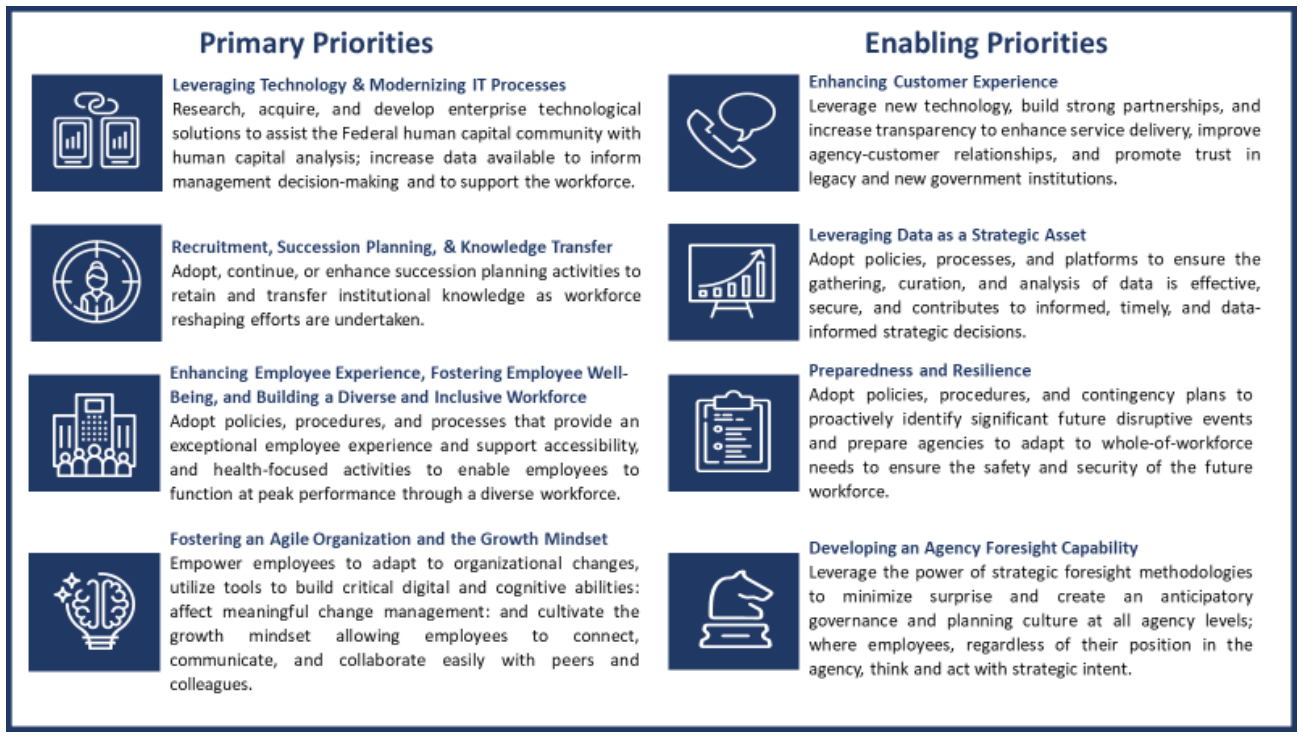

New priorities from the Office of Personnel Management, aligned with the President’s Management Agenda, aim to help agencies fix workforce issues, use better data...
Agencies have to choose two out of four new focus areas to help improve their workforce over the next four years.
Deciding which options are most impactful gives agencies flexibility in how they approach new workforce objectives from the Office of Personnel Management.
Although OPM’s federal workforce priorities report, released on May 10, asks agencies to focus on only two of the four focus areas, implementing all four can help agencies resolve bigger workforce issues.

Among four primary priorities and four enabling priorities, OPM hopes agencies can implement proactive approaches to common issues, such as recruitment challenges.
“Agencies can no longer afford to react to workforce and technological changes when they occur,” OPM wrote.
Instead, OPM said agencies can better face those issues partly by using data to determine personnel costs, streamlining policy creation and adoption and recruiting a diverse and highly skilled workforce.
The new objectives come as agencies have to balance other workforce-related initiatives such as the President’s Management Agenda. The PMA, along with executive orders focusing on concerns like advancing equity, as well as the budget request’s focus on strengthening the federal workforce, drive the content of the new focus areas from OPM.
These focus areas also come just after OPM released the results of the 2021 Federal Employee Viewpoint Survey, which showed a decline in employee engagement and satisfaction. The priorities aim to make long-term strategic changes to the federal workforce partly in an effort to reverse those results.
The goals center on common themes for agencies, including modernizing information technology, building diversity and enhancing recruitment practices.
The workforce objectives are “designed to support the administration’s initiatives such as rebuilding the workforce, defining the future of work and creating a workforce that looks like the country it serves,” OPM wrote in its memo.
The four enabling priorities will inform the work of their two chosen primary priorities, OPM wrote in the report.
“The enabling priorities are critical for designing visionary strategies, identifying metrics for success and measuring progress over the next four years,” OPM wrote. “Agencies should focus their efforts on two primary priorities but recognize that they will need to use the concepts espoused by the enabling priorities to maximize their success.”
Some enabling priorities include using data effectively, improving customer experience and preparing for potentially disruptive events in the future.
Recruiting the next generation of federal employees, basing workforce decisions on relevant data and bolstering employee diversity, equity, inclusion and accessibility are among the end goals from the report.
With those goals in mind, OPM aligned the priorities with Biden administration initiatives. Each one is mapped to a piece of the PMA.
For example, the recruitment-centered federal workforce priority from OPM parallels the first and fourth strategies of the PMA’s first priority: strengthening and empowering the federal workforce.

The report is the second of its kind, providing an update to OPM’s 2018 report, which outlined six priorities for agencies to implement. The new report does not eliminate the previous objectives. Instead, it builds on the last iteration.
With a new “crosswalk” concept, agencies can use focus areas from four years ago to continue informing their new priorities.
“Agencies should continue their efforts on the 2018 initiatives under an improved rubric,” OPM wrote.

The report is intended to be a more generalized approach to policy changes, OPM said. It’s not a prescriptive way for human capital workers to adhere to strict rules or a timeline.
“Rather, the President’s Management Agenda and cross-agency priority goals create a process for establishing such governmentwide requirements, and when developing human capital goals, the report may be considered as a source for useful insights and strategies,” OPM wrote.
As they plan out how to approach these focus areas over the next four years, agencies should work closely with OPM to determine the best continued approach.
In addition to collaborating directly with OPM, agencies can use the Open Opportunities platform, which automatically matches users across government to different opportunities based on skills data. Using the platform will enhance agencies’ implementation of the workforce priorities by finding new approaches and effectively addressing challenges, OPM said.
“In this time of unprecedented change, it is essential that the agencies continue to collaborate and share promising practices in all aspects of human capital management. The eight priorities outlined in this report will continue to be evaluated and refined as the future unfolds,” OPM wrote.
Copyright © 2025 Federal News Network. All rights reserved. This website is not intended for users located within the European Economic Area.
Drew Friedman is a workforce, pay and benefits reporter for Federal News Network.
Follow @dfriedmanWFED

